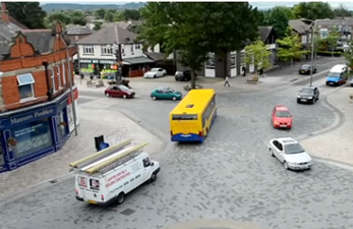A cross-party group of MPs has today published a report with recommendations, following an enquiry into disability and the built environment.
The enquiry looked closely at the issue of shared space, an area I have been concerned about for some time. I’m delighted that they have concluded, as I did in my own report published two years ago, that shared space creates serious safety concerns and excludes many people.

Lord Holmes of Richmond
The committee correctly identified the first barrier to clarity around the vexed question of shared space is that there is no definitive explanation of the term. The Department for Communities and Local Government states that 'within a shared space, the intention is to encourage all types of road users to share the full width of the street'.
Specific features of shared space are identified by the Chartered Institute of Logistics and Transport as 'the removal of traditional delineators between pedestrians and vehicles (such as kerbs and controlled crossing points) and the mixing of pedestrians and vehicles in the same street'.
It is these particular features of shared space that first alerted me to the issue. I am a guide dog user and removing a controlled crossing simultaneously removes my ability to safely and independently cross a road.
Shared space is believed to 'improve streetscapes', in particular by reducing vehicle speeds, and while I completely appreciate and approve of this objective I cannot support the use of pedestrians as human shields to these ends.
Observing that (most) vehicles slow down in a space shared with pedestrians is like pointing out that people cycle more slowly without a helmet and drive more carefully without a seatbelt and therefore banning cycle helmets and seatbelts to improve safety.
My own research found that regardless of their mode of transport, disability status or gender, an overwhelming majority of respondents did not enjoy using shared spaces. I also found a third of respondents went out of their way to actively avoid shared space.
The select committee gathered a considerable amount of evidence from individuals and organisations that supported these findings.
There is also a belief that shared space encourages footfall to an area and is often introduced by local authorities as a means of stimulating economic regeneration but it cannot make good economic sense to plan people out of their environments. The economic imperative and the accessible imperative, are not, and should not be perceived as, mutually exclusive.
The committee found that the Government does not seem to have grasped the seriousness of the barrier to inclusion that certain features (or the lack of certain features) present to so many disabled people.
I welcome the committee’s recommendation that the Government take a leadership role on this. Thus far the Government has abdicated all responsibility stating clearly and repeatedly that the duty lies with local authorities to get local planning right.

An example of shared space. (Photo Roman Cassini)
As local authorities continue to design and implement inaccessible schemes and then face a choice between costly retrofits or excluded communities, the Government must step in.
An admirably focused and detailed recommendation is that 'the Government require local authorities to call a halt to the use of shared space schemes, pending clear national guidance that explicitly addresses the needs of disabled people'.
'This should, in particular, instruct local authorities that controlled crossings and regular height kerbs are to be retained and that they should undertake an urgent review of existing schemes, working with disabled people in their area to identify the changes that are necessary and practicable.'
A further recommendation is that the Government urgently replace the 2011 LTN on shared spaces with new guidance, founded on inclusive design approach, to ensure that any resultant schemes are inclusive, navigable and welcoming for disabled people and although adequate guidance is important they rightly point out that individuals also need an accessible means to challenge decisions when such guidance is not adhered to.
Current legislation, under the Equality Act, requires public bodies to make reasonable adjustments, which though conceptually sound has proved difficult to establish in practice. The committee recommends regulations be brought forward to ensure the updated guidance would be enforceable under law.
The impact on people’s lives when public spaces are not accessible is devastating. Inclusive design must be the golden thread that runs through all new buildings and works in the public realm.
There will be a real opportunity when the new government comes in to address a widespread and growing problem and I applaud the select committee for recognising the seriousness of the issue and producing such clear and effective recommendations.
Register now for full access
Register just once to get unrestricted, real-time coverage of the issues and challenges facing UK transport and highways engineers.
Full website content includes the latest news, exclusive commentary from leading industry figures and detailed topical analysis of the highways, transportation, environment and place-shaping sectors.
Use the link below to register your details for full, free access.
Already a registered? Login